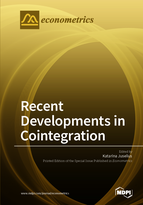Recent Developments in Cointegration
A special issue of Econometrics (ISSN 2225-1146).
Deadline for manuscript submissions: closed (28 February 2017) | Viewed by 84518
Special Issue Editor
Special Issue Information
Dear Colleagues,
This Special Issue contains recent contributions to empirical and theoretical cointegration models. Methodologically oriented papers that combine the two are particularly welcome. I envision papers that, for example, apply cointegration in a novel way, suggest a new way of testing hypotheses in a Cointegrated VAR model, derive new tests motivated by empirical applications, use cointegration analysis to solve interesting problems in macroeconomics and finance, such as the puzzling long, persistent swings around long-run equilibrium values. Papers dealing with near integration (near I(1) and near I(2)) are much welcome. Additionally, papers applying the I(2) cointegration and the fractional cointegration model to relevant economic problems are of great interest and so are theoretical advancements to these models. Cointegration models that address the problem of time-varying coefficients, changes in the equilibrium mean and changes in the mean growth rates are all within the scope of this Special Issue.
More generally, the purpose of the Special Issue is to advance cointegration techniques needed to properly address recent problems in macroeconomics and finance, in particular, problems that became painfully visible during the great recession. For example, using cointegration as a means to address self-reinforcing feed-back loops could potentially add valuable information about some of the mechanisms that generated the recent crisis.
Prof. Katarina Juselius
Guest Editor
Manuscript Submission Information
Manuscripts should be submitted online at www.mdpi.com by registering and logging in to this website. Once you are registered, click here to go to the submission form. Manuscripts can be submitted until the deadline. All submissions that pass pre-check are peer-reviewed. Accepted papers will be published continuously in the journal (as soon as accepted) and will be listed together on the special issue website. Research articles, review articles as well as short communications are invited. For planned papers, a title and short abstract (about 100 words) can be sent to the Editorial Office for announcement on this website.
Submitted manuscripts should not have been published previously, nor be under consideration for publication elsewhere (except conference proceedings papers). All manuscripts are thoroughly refereed through a single-blind peer-review process. A guide for authors and other relevant information for submission of manuscripts is available on the Instructions for Authors page. Econometrics is an international peer-reviewed open access quarterly journal published by MDPI.
Please visit the Instructions for Authors page before submitting a manuscript. The Article Processing Charge (APC) for publication in this open access journal is 1400 CHF (Swiss Francs). Submitted papers should be well formatted and use good English. Authors may use MDPI's English editing service prior to publication or during author revisions.
Keywords
- Cointegrated VAR models for I(1), I(2), fractionally integrated and explosive root data
- Inference in near integrated processes
- Hypothesis testing
- Structure analysis
- Time-varying coefficients
- Modelling changes in equilibrium means and mean growth rates






